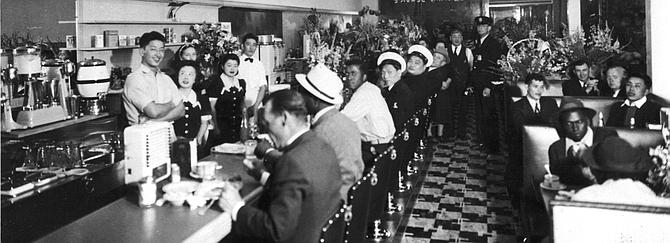 Facebook
Facebook
 X
X
 Instagram
Instagram
 TikTok
TikTok
 Youtube
Youtube

Asian Story Theatre’s Stories of the Sun Café runs three performances through the weekend of June 27-29. Written by Kent Brisby, who researched the subject with Joyce Teague for two years, the piece is the biography of a place and a history of the changing times.
In 1921, the Asian community in San Diego was mostly male. And most of them were bachelors who sailed, says a poem, to the “sandalwood hills and mountains of gold...their fortunes to earn/Then to their homes and village return.”
Obayashi Uichiro was a first generation Japanese American — Issei. He opened a shooting gallery/confectionary at 421 Market, between Third and Fourth. Noticing that many of his young male clientele looked hungry, he began selling soup. The tasty, filling, reviving soup became so popular that he converted the gallery into the Sun Café in 1921. When it closed in 2008, the eatery was one of San Diego’s oldest and most popular.
As you entered, if you knew its past, the long, narrow room could have been a shooting gallery, the targets straight ahead on the south wall. On one side: stools and a long counter; on the other, red Naugahyde booths; the floor, checkerboard linoleum; the food, not gourmet but abundant and reasonably priced; the acoustics, lively.
The building was constructed in the late 1870s, which made the cafe one of those Time Machine places: you could sense history out the corner of your eye. The unfussy, vinyl décor was pure Fifties (someone called it a “retro-Woolworth’s dining counter”), the architecture much older.
Legends ate here. Ah Quin, the “Mayor of Chinatown,” often used the Sun Café as a meeting place. So did Esaki Ainosuke. He owned a nearby nursery and was a co-worker with Kate Sessions, the famous horticulturalist. In 1940 he developed the world-renowned strain of red bougainvillea, “San Diego Red.”
Also Tom Hom, the city’s first successful Asian politician, and young Joe Yamada. He worked as a waiter and later became San Diego’s leading landscape architect.
During World War II, when the Japanese population was sent to internment camps — allegedly “for their own good” — a Greek family ran the café. It was later purchased by the Chinese Jeong family.
When Judy Jeong took an order, she never wrote it down. And she totaled up the bill not at the register, but in long hand on the order pad.
Between 2009 and 2012, John Wotzka wrote “The Sun Café Moves On,” a series of community blogs for the Reader. He was a dishwasher at the café for 14 years, and writes with passion and heartbreak about having to let go — even long after it closed.


Asian Story Theatre’s Stories of the Sun Café runs three performances through the weekend of June 27-29. Written by Kent Brisby, who researched the subject with Joyce Teague for two years, the piece is the biography of a place and a history of the changing times.
In 1921, the Asian community in San Diego was mostly male. And most of them were bachelors who sailed, says a poem, to the “sandalwood hills and mountains of gold...their fortunes to earn/Then to their homes and village return.”
Obayashi Uichiro was a first generation Japanese American — Issei. He opened a shooting gallery/confectionary at 421 Market, between Third and Fourth. Noticing that many of his young male clientele looked hungry, he began selling soup. The tasty, filling, reviving soup became so popular that he converted the gallery into the Sun Café in 1921. When it closed in 2008, the eatery was one of San Diego’s oldest and most popular.
As you entered, if you knew its past, the long, narrow room could have been a shooting gallery, the targets straight ahead on the south wall. On one side: stools and a long counter; on the other, red Naugahyde booths; the floor, checkerboard linoleum; the food, not gourmet but abundant and reasonably priced; the acoustics, lively.
The building was constructed in the late 1870s, which made the cafe one of those Time Machine places: you could sense history out the corner of your eye. The unfussy, vinyl décor was pure Fifties (someone called it a “retro-Woolworth’s dining counter”), the architecture much older.
Legends ate here. Ah Quin, the “Mayor of Chinatown,” often used the Sun Café as a meeting place. So did Esaki Ainosuke. He owned a nearby nursery and was a co-worker with Kate Sessions, the famous horticulturalist. In 1940 he developed the world-renowned strain of red bougainvillea, “San Diego Red.”
Also Tom Hom, the city’s first successful Asian politician, and young Joe Yamada. He worked as a waiter and later became San Diego’s leading landscape architect.
During World War II, when the Japanese population was sent to internment camps — allegedly “for their own good” — a Greek family ran the café. It was later purchased by the Chinese Jeong family.
When Judy Jeong took an order, she never wrote it down. And she totaled up the bill not at the register, but in long hand on the order pad.
Between 2009 and 2012, John Wotzka wrote “The Sun Café Moves On,” a series of community blogs for the Reader. He was a dishwasher at the café for 14 years, and writes with passion and heartbreak about having to let go — even long after it closed.
Comments